Eating Kashmiri Wazwan
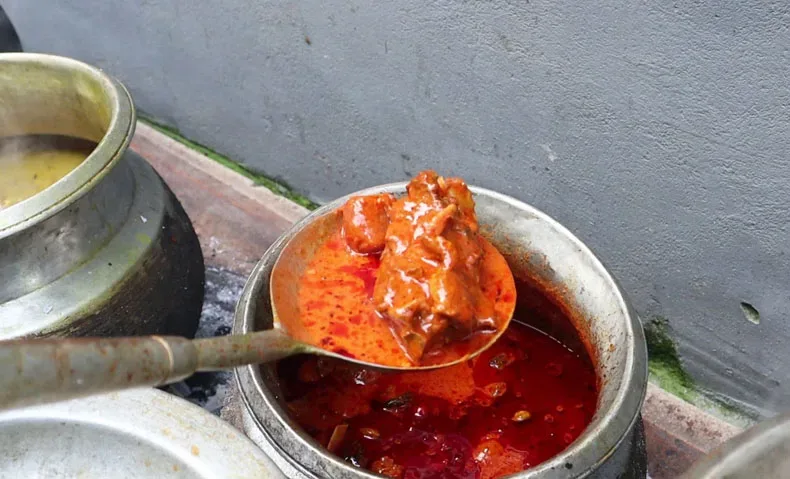
Our Kashmiri writer shares the experience of wazwan, the famous multicourse feast of Jammu and Kashmir, and where to try it in Srinagar.
In the northernmost part of India, Kashmir is world-famous for several reasons, from its handmade shawls to its stunning natural beauty. But one thing you may not be familiar with Kashmiri wazwan, its renowned cuisine.
Wazwan (also spelled wazawan) is a traditional multicourse meal, served on special occasions such as weddings and festivals. This grand feast consists of around 36 dishes, a variety of meats, vegetables, and rice meant to showcase the incredible flavors and unique cooking techniques found in this cuisine. The word wazwan is derived from the Persian wazan, which means weight or balance, indicating the elaborate and balanced nature of the meal.

The famous houseboats on Dal Lake in Srinagar, summer capital of Jammu and Kashmir. Photo courtesy of Yeoboya/Flickr.
ORIGINS OF WAZWAN
The origins of Kashmiri wazwan can be traced back to the royal courts of the Mughal emperors, who ruled over the Indian subcontinent from the 16th to the 19th century; Mughlai cuisine as a whole is famously rich. But while wazwan was introduced to Kashmir by the Mughals, over time, Kashmiris perfected and blended it into their own culture.
Today, wazwan is an integral part of Kashmiri culture, and the preparation of it is considered an art form. The chefs who have perfected this art over generations are called wazas. They generally prepare the meal with the help of an eight- to 10-person team.
Not every chef can prepare wazwan, as it requires rigorous practice, talent, and hard work. The cooking art is usually passed down from one generation to another, and wazas start learning from a very young age.
Traditionally wazwan is served in Kashmir for weddings and other special occasions, like the birth of child or Eid. Locals will visit a waza at his home (they are traditionally always male) and place an order; he’ll generally set a time frame of two to three days to prepare the meal. For weddings, the waza and his team set up a huge temporary kitchen in which to make everything, at the house where the wedding takes place.
You can also find wazwan in restaurants across Srinagar, the summer capital of Jammu and Kashmir. But because most diners want to eat Indian, Western, and fast food in restaurants, most restaurant chefs are not expert at preparing wazwan, and the quality just isn’t there. (See the bottom of this post for one restaurant we do recommend.)

Preparing wazwan in an outdoor kitchen. (The waza here is wearing the green sweater.) All photos by Zain Shah except where indicated.
HOW WAZWAN IS PREPARED
Wazwan is cooked over a wood fire, slowly to enhance flavors, in huge copper pots called degs. The meal is typically served on large copper platters known as tramis, which hold enough food for four people and feature beautiful hand-etched designs. Each dish is carefully arranged and presented with great attention to detail, decorated with colorful spices and herbs.
The first step in preparing Kashmiri wazwan is to make the stock. Typically, an animal is slaughtered in advance—a sheep aged somewhere between a lamb and a mutton. After the meat is chopped and added to a water-filled deg, it cooks slowly, and is then seasoned with garlic and salt. This mutton broth forms the base for the rest of the dishes in the wazwan.
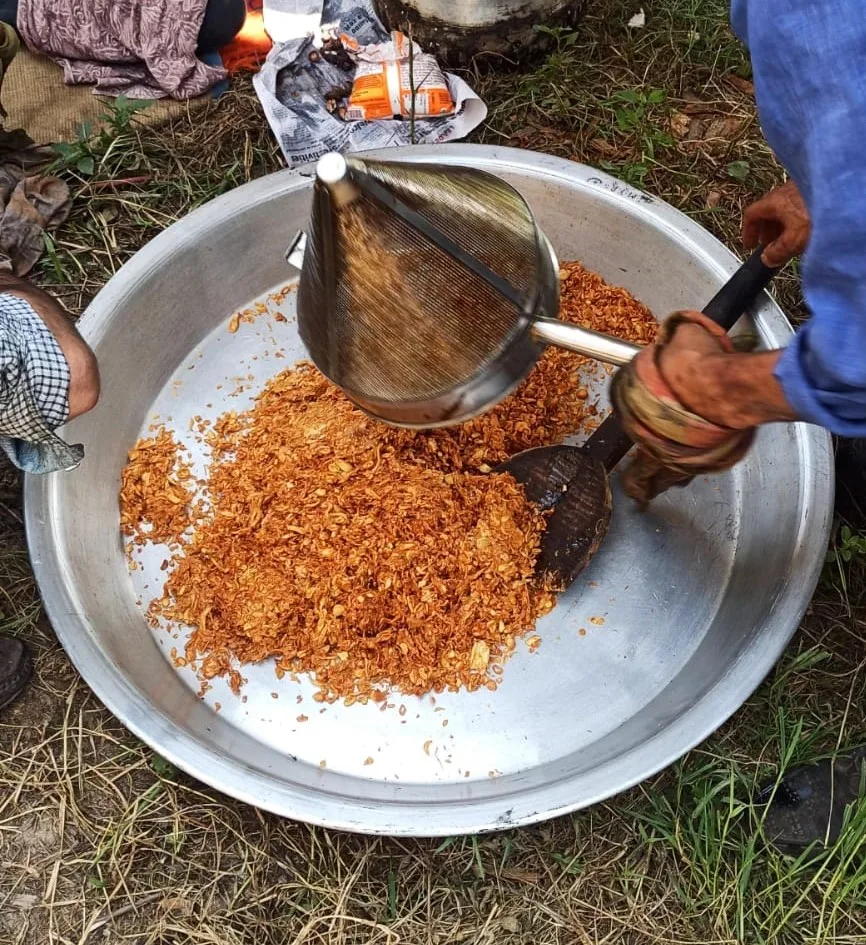
Deep-fried shallots to become shallot paste (via a mortar and pestle) for wazwan.
Next, the natural reddish food coloring known as mawal (in Kashmiri language) or cockscomb (celosia cristata) is prepared. The flowers are beaten with a huge mortar and pestle to obtain the ideal hue, later used to give some of the wazwan dishes, like methi and rogan josh, their rich color.
It’s important to note that no synthetic colors or spices are used in wazwan. From start to finish, the meal uses only natural ingredients.
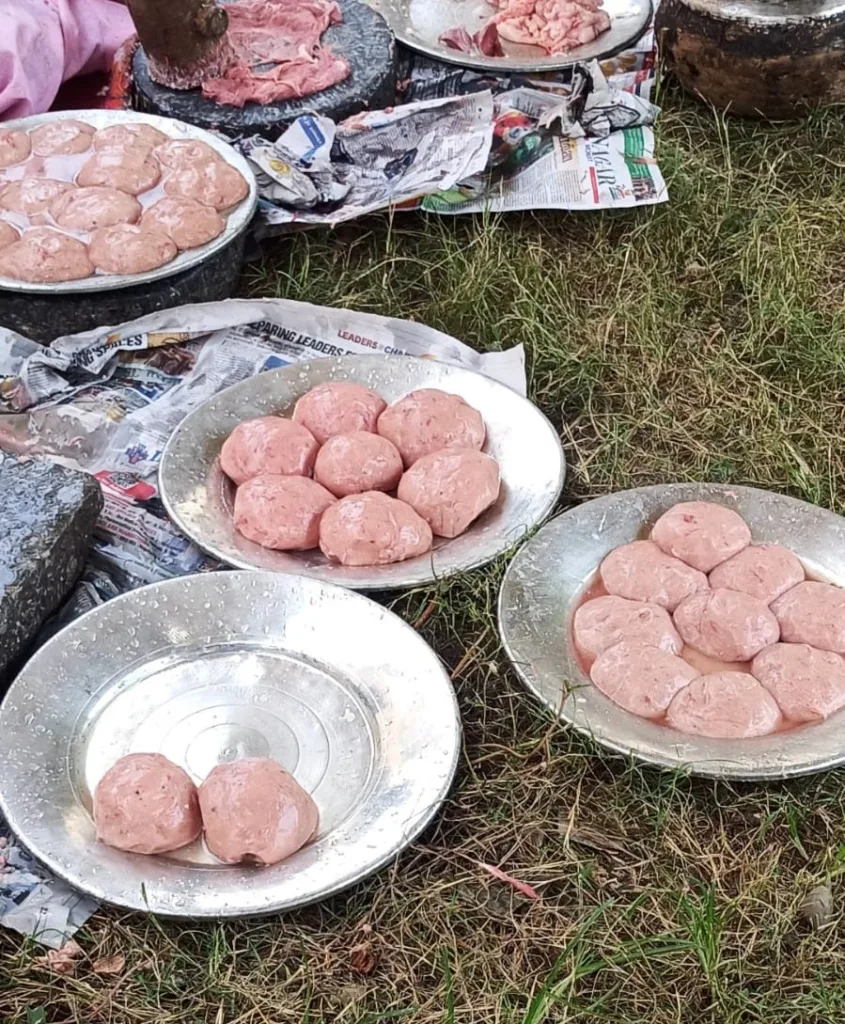
Gushtaba, a lamb meatball, ready to be cooked for wazwan.
THE FEAST: TYPICAL WAZWAN DISHES
Wazwan usually consists of around 36 dishes, although the exact number can vary depending on the occasion and number of guests. The meal is served in a specific order, starting with a series of appetizers and progressing through the main courses, before concluding with desserts. Here are 10 of the most popular Kashmiri wazwan dishes.
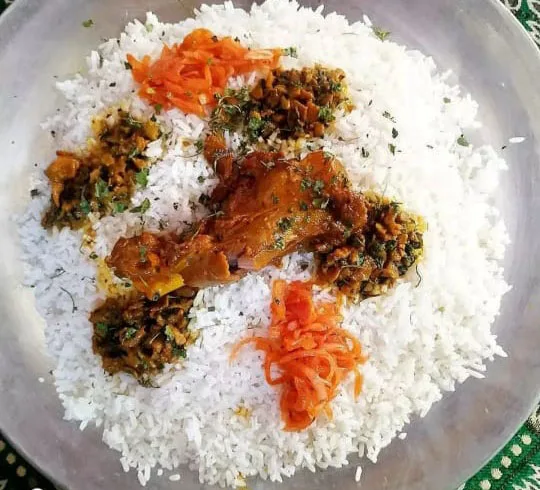
Rice with methi maaz (four scoops) and tabaz maaz (in center) on a trami. Photo courtesy of Maroof Qureshi.
Methi Maaz
Methi is the typical appetizer of wazwan, a mutton dish served alongside tabak maaz (see next) on a trami and covered with a sarposh, or lid. It is prepared using mutton tripe and fenugreek leaves.
First, the meat and intestine are boiled, then finely chopped with a heavy knife on a wooden log (called a mound in Kashmiri). The waza marinates the mutton in a mixture of yogurt and spices, which include cumin, coriander, ginger, garlic, and Kashmiri red chili powder. The meat is then added to the deg and cooked in ghee over low heat along with fresh fenugreek leaves until it is tender and the flavors have melded together.
The slight bitterness of the fenugreek pairs perfectly with the succulent meat, and the blend of spices creates a depth of flavor that’s deliciously satisfying. Methi is spongy and tastes phenomenal with steamed rice: a rich, spicy match made in heaven. It’s a dish we can’t get enough of.
Tabak Maaz
This dish is believed to have originated in the royal kitchens of the Mughal emperors. It is a popular starter made from deep-fried mutton ribs that are seasoned with spices until they’re crispy on the outside and juicy on the inside.
The flavors are intense, and the texture perfect. The ribs are steamed in a broth with spices such as clove, garlic, garam masala, asafoetida, and aniseed. (It’s important to note that very little to no turmeric and chili powder are added, despite what some sources on the internet may say.) Once steamed, the ribs are cut into pieces and placed on a large copper plate called a majme, which bulges a bit in the center. Then, they are slowly fried in ghee and mutton fat. The final result is the tabak maaz, which is crisp and brown on the outside and incredibly soft and juicy on the inside.
Despite the few spices used, the flavor of these ribs is incredible. One reason for this is that tabaz maaz is fried in ghee alongside melted mutton fat—this infuses a unique flavor into the meat, absorbed slowly over the simmering wood fire. The soft, tender meat melts like butter in your mouth, releasing all of that rich mutton-fat flavor.

A goshpare being used to hand-grind meat for rista and gushtaba.
Rista
Rista is a traditional Kashmiri meatball made from ground mutton meat and fat. After the animal is slaughtered, the meat and fat are separated for the preparation of this dish. With the help of a wooden hammer (a goshpare, in Kashmiri), the mutton meat is manually ground on a large rock until it turns into a fine paste; lamb fat is also added during the process. Connective tissues, fibers, and veins are removed during this pounding process. Once the meat is finely ground, spices such as black cardamom, cinnamon, clove, garam masala, shallot paste, garlic, fennel powder, and more are added.
Meatballs are then prepared and soaked in warm water for a while. The meatballs are cooked in a rich, tomato-based gravy flavored with aromatic spices such as saffron, cinnamon, and cardamom. Finally, they are steam-cooked over the wood fire.
The result, rista, is an incredibly delicious, soft meatball with incredible flavor, thanks to all those spices. The thick, velvety gravy complements the meat perfectly.
Kebab
Another essential Kashmiri wazwan dish is the kebab, skewered mutton meat marinated in a blend of spices and grilled to perfection using mutton fat. The kebabs are tender and moist and have a delicious smoky flavor, infused with spices like garam masala, cardamom, cinnamon powder, ginger, garlic, cumin, onion paste, and of course the wood fire itself. The secret to its distinct taste, however, is the addition of chicken meat to the mutton.
As you devour a kebab, the meat further releases its juices and signature smoky flavor. They’re truly a delight to eat.

Rich, velvety, red rogan josh, pictured in a traditional deg.
Rogan Josh
Rogan josh is perhaps the most famous Kashmiri wazwan dish (particularly in the UK, where it’s a staple at every London curry house). It is a mutton curry cooked in a spicy yogurt-based sauce. The tender chunks of meat are seasoned with aromatic spices like Kashmiri chili powder, cardamom, cinnamon, fennel powder, shallot paste, and dried ginger powder that impart an unforgettable taste.
The dish is named for its rich red color (rogan means red), which comes from the chili powder, though that mawal coloring helps too. The meat is so tender that it falls off the bones. Rogan josh is spicy and tangy, and the slow cooking pulls all the juice from the meat and bones, adding flavor and texture. The bold spices and tender mutton in rogan josh bring a tantalizing, mouth-watering heat.
Kashmiri Pulao
Pulao is a fragrant basmati rice dish with origins in Persian cuisine; this version was adapted to Kashmiri tastes with the addition of saffron, raisins, and nuts (almonds and cashews), which are commonly found in the region. It is generally golden brown due to the onion paste used in its preparation.
This basmati rice is sweet and aids in digestion, providing balance to the rich and spicy dishes served. It is usually prepared as a side for the wazwan, although it is also a separate main dish in Kashmiri cuisine.
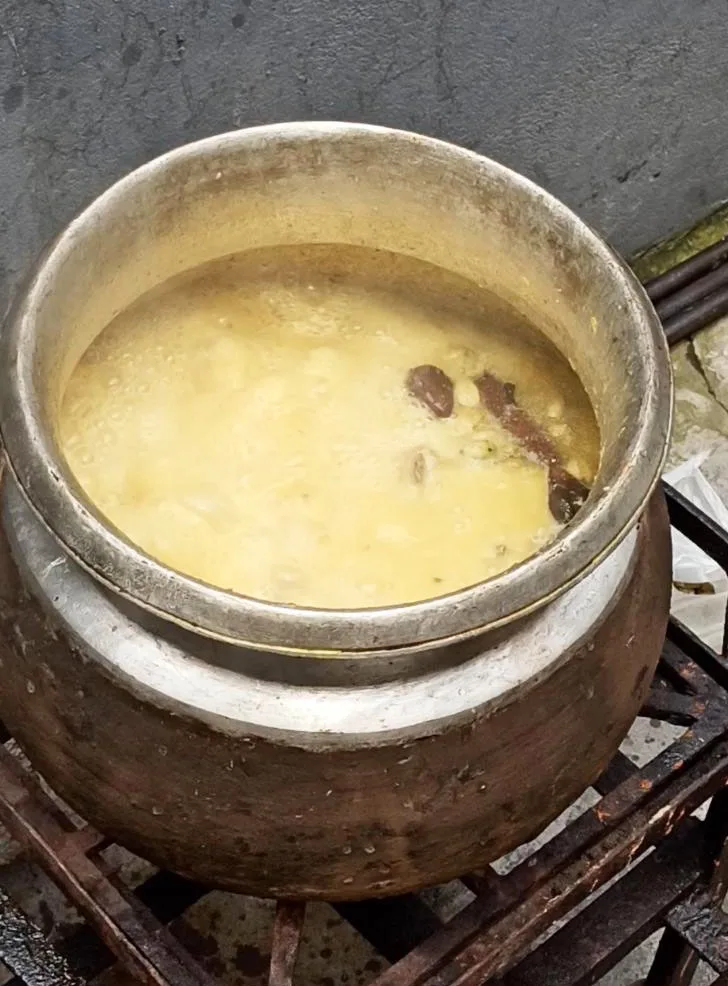
Aab gosh, a creamy mutton curry, in a traditional deg, or copper pot.
Aab Gosh
Aab translates to “water” in Kashmiri, and as the name suggests, it is mouth-watering—even just for this writer to think about it! Aab gosh is prepared from the hip meat of a sheep, cooked in a sauce made of buffalo milk that’s simmered until creamy. Bone broth, meat stock, and ghee are added along with spices such as black cardamom, shallot paste, green cardamom, and fennel powder. This meat is slowly cooked over a wood fire, blending each flavor in unison.
The taste is celestial. The dish is sweet, but not too sweet. The interplay of cream, ghee, and all the spices makes it perfectly balanced. You will be blown away!
Dhaniwal Korma
Another interesting wazwan dish is dhaniwal korma, a mutton curry that’s cooked with whole onions, herbs, and spices including garam masala, clove, green cardamom, cinnamon, fennel powder, garlic paste, and ginger paste. The onions are sweet and tender, adding a distinct texture and flavor to the dish.
What sets this dish apart is the creamy, zesty sauce. The tender meat is cooked in yogurt with both ground and freshly chopped coriander (cilantro). Coriander binds the flavor of all the spices and gives this dish balance. With its mild spice and fresh herbs, dhaniwal korma might be considered the perfect foil to rogan josh.
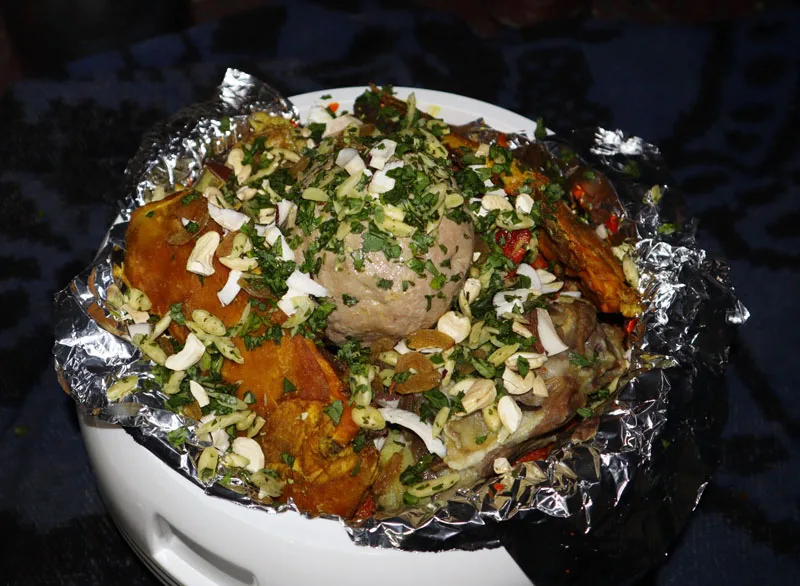
A gushtaba (lamb meatball) under nuts, cilantro, and mint.
Gushtaba
This is a signature concluding dish of Kashmiri wazwan, made from minced mutton that is hand-beaten for hours until it takes on a soft, dough-like texture. It is then shaped into large meatballs and cooked in a spiced creamy yogurt sauce called yakhni. This thick, rich yakhni curry, flavored with fennel, cardamom, mint, and other aromatic spices, is what makes gushtaba so unique.
The meatballs become incredibly soft and tender, and the velvety sauce just envelops them. It’s absolute decadence, and it sings with bursting, balanced flavors. Gushtaba is not very spicy, but the flavors are so complex and nuanced that you’ll find yourself slowing down, trying to identify all of them. It’s a perfect savory dish to end on.
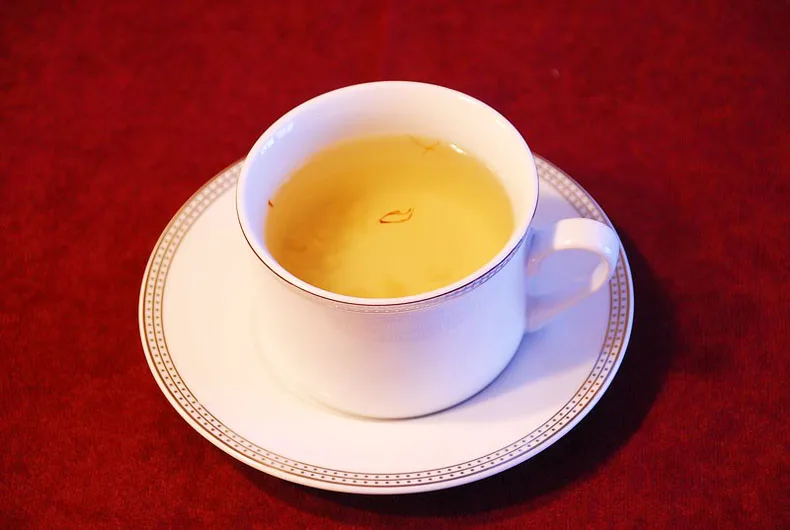
Kashmiri saffron kehwa, the tea drunk during a traditional Kashmir wazwan feast.
Kashmiri Saffron Kehwa
You might have heard the word kehwa or kahwa in pop culture, with reference to India and especially Pakistan. Although kehwa is prepared in parts of Pakistan, Iran, and Afghanistan, Kashmiri saffron kehwa chai is unique in its preparation and spices. After the heavy feast of wazwan, it’s a dessert tea served primarily to assist with digestion. It includes the world-famous Kashmiri saffron along with green cardamom and Kashmiri almonds.
Similar to green tea in appearance, it’s golden green, but it has an incredibly sweet, green cardamom-spiked taste. The sweetness is balanced by the spices, making for a wonderful blended tea. The aroma of cardamom fills the entire room while kehwa is brewed and served!

View of Srinagar and Dal Lake. Photo courtesy of Ryaan Khan.
Where to Eat Wazwan in Srinagar, Jammu and Kashmir
Wazwan is a celebration of the community and a testament to the rich culinary heritage of Kashmir, a region shaped by centuries of cultural and historical influences. Naturally, if you are traveling to Kashmir, you should try to experience the delicious food, beautiful presentation, and exceptional hospitality of wazwan yourself!
One option—the best one, if it’s possible—is to find a professional waza who will cook a fresh multicourse meal right in front of you. One such waza, known all over, is Lateef Khosa (known locally as Khosa Waza) located in the Nawid Kadal area of old Srinagar. He’s cooked for many famous personalities over the years (fortunately for my family, he was friendly with my grandfather, and cooked at my parents’ wedding). It might be hard for the average tourist to make this happen, of course, so a restaurant is the next best bet.
ass=”yoast-text-mark”>ass=”yoast-text-mark”>ass=”yoast-text-mark”>ass=”yoast-text-mark”>ass=”yoast-text-mark”>ass=”yoast-text-mark”>ass=”yoast-text-mark”>ass=”yoast-text-mark”>ass=”yoast-text-mark”>ass=”yoast-text-mark”>ass=”yoast-text-mark”>ass=”yoast-text-mark”>ass=”yoast-text-mark”>ass=”yoast-text-mark”>ass=”yoast-text-mark”>ass=”yoast-text-mark”>ass=”yoast-text-mark”>ass=”yoast-text-mark”>yle=”background-color: #f4f4f4; border-radius: 50%; flex-grow: 0; height: 40px; margin-right: 14px; width: 40px;”>View this post on Instagram
Many restaurants cook Kashmiri wazwan that’s not of good quality—it’s like a knockoff of a popular brand, using synthetic spices and also often making the food too spicy for some Western palates. But one that does a good job is Ahdoo’s, an historic hotel and restaurant that has carved a niche for itself in wazwan and is located in the heart of Srinagar, on Residency Road (map). It claims it was the first restaurant established in the Kashmir Valley, in 1918. At Ahdoo’s you can build your own trami plate, pictured above (with your choice of three non-veg dishes and two veg dishes), for 900 INR, or about US$11.
(By contrast, it would generally cost about 6,000 INR, or US$73, for a full trami with a waza, which would be a complete wazwan for four people.)
However you can find it, experiencing wazwan, and the distinct delights of Kashmiri cuisine, is an absolute must in this part of India.
About the author: Zain Shah is a student hailing from the breathtaking land of Kashmir. His ardent love for his homeland stems from its rich cultural heritage, its tantalizing cuisine, and its distinctive crafts that epitomize Kashmiris’ identity. He writes at Shopability.shop and Kashmir-Arts, a store for authentic Kashmiri products.
Updated: March 18, 2024


